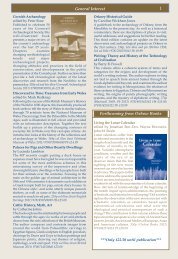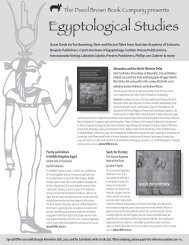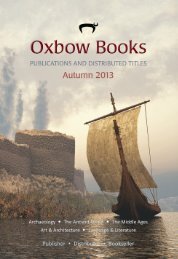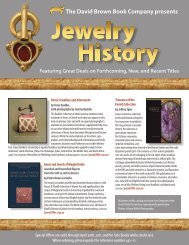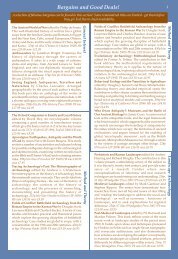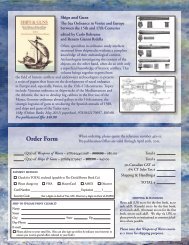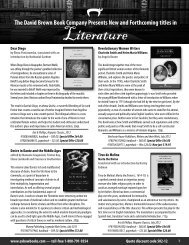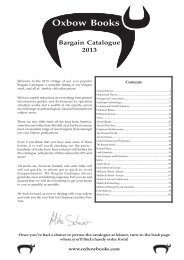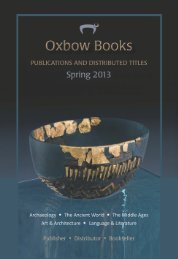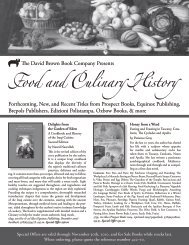NAPLES YELLOW - Oxbow Books
NAPLES YELLOW - Oxbow Books
NAPLES YELLOW - Oxbow Books
You also want an ePaper? Increase the reach of your titles
YUMPU automatically turns print PDFs into web optimized ePapers that Google loves.
Maiolica scodella, made<br />
in Northern Italy (Castel<br />
Durante), probably<br />
painted by Nicola da<br />
Urbino, c.1533–8. This<br />
bowl is decorated with<br />
typical childbirth scenes<br />
and would have held<br />
nourishing soup for the<br />
new mother. The lid<br />
shows both the birth and<br />
an astrologer divining the<br />
child’s future. A second<br />
scene at the bottom of<br />
the bowl, which depicts<br />
the newborn baby, would<br />
have been revealed when<br />
the bowl was emptied.<br />
V&A: C.2258&A–1910<br />
84 COOKERY<br />
CHICKEN SOUP<br />
To make a tasty broth of capons<br />
SOME CONSIDER THIS BROTH TO BE MARVELLOUS FOR CONVALESCENTS,<br />
but I have made it to order for physicians many times. Take<br />
a capon chopped in pieces as above [as small as possible,<br />
rinsing once to remove any blood, cover with water and<br />
boil], simmer gently in a pan until you have removed all the<br />
scum that rises to the surface. With an earthenware lid over<br />
the pan, leave to simmer for one hour with a thin slice of<br />
prosciutto […] which adds taste to the broth and satisfi es the<br />
listless. Remove the prosciutto […] and add an eighth of an<br />
ounce of cinnamon. Let it reduce by more than half its original<br />
volume, strain through a sieve and make a minestra from<br />
this broth, as it is more suitable for minestre and<br />
little fi ne broths than to give as a drink.<br />
Capons are ‘more nutritious than all other foods […] generate perfect blood<br />
and balance all the humours’, according to Castor Durante, Il Tesoro della sanità<br />
(The Treasury of Health) (1585). The recipe above comes from the fi nal part of<br />
Bartolomeo Scappi’s famous cookbook (see p.87), which deals with foods for<br />
‘convalescents’. This broth was generally considered by physicians like Ulisse<br />
Aldrovandi to be the ideal food to ‘rally the sinking strength of their patients’,<br />
above all for the elderly, the feverish and women in pregnancy and childbirth.<br />
So when the wife of Miho Bunic, a Dubrovnik nobleman, aged 36, contracted<br />
fever after having twins (one of which died instantly after birth), her expert<br />
physician, Amatus Lusitanus, prescribed capon broth and other invigorating<br />
foods (porridge and watermelon seeds). Leonardo Fioravanti (see p.73) in<br />
his Compendio dei secreti naturali (Compendium of Natural Secrets) (Venice, 1564)<br />
supplied a recipe for this broth, ‘called brodo consumato in Rome, sorcicco in<br />
Naples and consumato in Venice’, along with others for highly nutritious ‘little<br />
fi ne broths’ (with eggs, parsley or other herbs) for the sick. He called for sugar<br />
to be added, which Scappi similarly included in his fi rst and longer recipe for<br />
brodo consumato (intended as a drink). Walther Hermann Ryff, the prolifi c author<br />
of books of secrets for ‘the common man’, also provided a recipe for chicken<br />
soup in his Kochbüch für die Krancken (Cookbook for the Sick) (Frankfurt, 1545), for<br />
Germany’s leading publisher, Christian Egenolff.<br />
Special maiolica wares for childbirth (including maiolica and wooden bowls for<br />
these broths) were commonly given as gifts in Renaissance Italy. Illustrated<br />
here from the Piccolpasso manuscript (see p.23) is one example, a fi ve-piece<br />
stacking set, comprising a salt cellar, bowl, trencher, bowl on a high foot and<br />
its lid, ‘a thing of no small ingenuity’. These sets (and simpler ones of just a<br />
bowl plus lid) were referred to as ‘scodella da impagliata’ (childbirth bowls).<br />
Other reviving superfoods given to women before and after birth included<br />
zabaglione, with recipes in both Scappi and La Commare (The Midwife) (Venice,<br />
1596) by the Roman physician Scipione Mercurio. In England, new mothers<br />
were given posset – warm milk curdled with ale, spiced and often thickened<br />
with eggs – and the V&A has several specially designed two-handled posset pots<br />
(in the British Galleries). In Italy, following childbirth, friends and relatives<br />
brought refreshments on specially painted wooden trays (deschi da parto),<br />
generally special treats purchased from apothecaries, such as comfi ts – sugarcoated<br />
aniseed or coriander seeds.<br />
COOKERY<br />
Stacked bowl set for<br />
pregnant women from<br />
Cipriano Piccolpasso,<br />
I tre libri dell’arte del<br />
vasaio (Castel Durante,<br />
1556–9), manuscript.<br />
V&A/NAL:<br />
MSL/1861/7446, f.11r<br />
85




